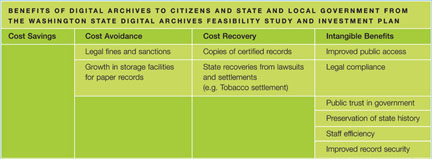Managing and Preserving State Government Digital Information
 Information and records custodians such as state archives, records management agencies, and libraries have traditionally provided long-term public access to significant government information in paper and other traditional formats. More and more, however, this information is being created solely in digital form. Much of it has only short-term value, but a considerable fraction must remain available for many years, or in some cases, permanently. Digital information with long-term cultural and historical value can include anything from California’s official state budget, which is now issued exclusively in digital form, to digital recordings of legislative sessions, to the electronic correspondence of key government officials.
Information and records custodians such as state archives, records management agencies, and libraries have traditionally provided long-term public access to significant government information in paper and other traditional formats. More and more, however, this information is being created solely in digital form. Much of it has only short-term value, but a considerable fraction must remain available for many years, or in some cases, permanently. Digital information with long-term cultural and historical value can include anything from California’s official state budget, which is now issued exclusively in digital form, to digital recordings of legislative sessions, to the electronic correspondence of key government officials.
All signs point to continued growth in the volume and complexity of “born digital” government information. However, most states are hampered in their efforts to respond to this growth by a combination of technology, policy, political, and management issues, complicated by fragmented organizational roles and responsibilities for managing and preserving digital information.
While traditional information and records custodians agree that not all digital information produced by government is worth saving, all agree that a small portion of this material is of permanent legal, legislative, or cultural value. In addition, a much larger portion has short and medium term value to CIOs, state and local agencies, the private sector, and citizens for purposes of e-government, e-commerce, and day-to-day government administration.
To address these challenges, traditional information and records custodians and other key stakeholders, such as chief information officers (CIOs), need to reorient strategies toward sharing information and assets and understanding common- alities rather than emphasizing differences. It is time to move beyond debates over terminology and start treating digital information as a “public asset” with multiple values to both government and society.
An important first step in developing effective strategies is to understand the existing technology, policy, and management contexts that make managing and preserving state government digital information such an important yet challenging issue.
The Value of Digital Information Management and Preservation
State strategies to communicate the value of digital information management and preservation include:
- The ability to clearly identify and manage digital government information of value supports government business continuity
- and disaster recovery planning efforts.
- Making digital information available for use and reuse supports e-government and e-commerce transactions.
- Accessibility and availability of government records and documents can increase public trust in government.
- More efficient storing, managing, researching, and retrieving of digital information can result in cost savings at the local government level.
Technology
Technology has had profound impacts on the creation, access, storage, and preservation of government digital information. According to a US Library of Congress report, “the record of government information is jeopardized by the transformation that digital technology is forging. This new technology has spawned a tremendous amount of information that is extremely fragile, inherently impermanent, and difficult to assess for long-term value.”

CTG worked with the US Library of Congress to help states and territories develop strategies for preserving significant state and lcoal govenrment information in digital form.
For example, in Arizona, information and records custodians highlight the challenges of managing and preserving legisla- tive proceedings, which are now captured using digital video without transcription. According to representatives from the Arizona State Library, Archives and Public Records, “There is no inherently stable video format to which we can transfer this information for preservation.” In addition, working with this format requires specialized technical skills and equipment. Unlike a paper, or even an electronic document, “it cannot be key-word searched, nor can it be easily skimmed” to assess its value for preservation.
Policy
In most states, policy authority for archiving government digital information is dispersed across traditional information and records custodians, CIOs, operating agencies, and even branches of government. This authority can take the form of legislation, standards, operating guidelines, and even specialized services. This array of policy instruments has contributed to the increasing fragmentation of responsibilities for managing state government digital information.
In a 2006 Center for Technology in Government (CTG) survey, supported by the Library of Congress, state archivists, records managers, and librarians from all 50 states and several territories indicated that authority for setting standards for creation and maintenance of digital information resides primarily outside of traditional information and records agencies. Instead, information technology organizations, in particular, stand out across all three branches of government as holding a significant role in the standards-setting process and in providing services related to the management of digital information.
One example comes from Georgia. The Georgia Technology Authority (GTA), headed by the state’s CIO, has authority over many data management standards for government digital information. As a result, the state archives has made it a priority to work cooperatively with GTA on standards development. The archives and GTA collaborated on the state’s Design Criteria Standard for Records Management Applications. This policy, which reflects both IT and records management expertise, defines the standards state agencies must use when purchasing records management applications.
Management
The combination of technology and policy has a significant impact on the management context when it comes to government digital information. For example, government agencies in many states are deciding to maintain digital information for the long-term within their own agencies, rather than in a specialized records center or archive. These agencies and their IT staff are questioning the need to send government digital records to the state archives and libraries due to their own “archiving” capabilities.
In Louisiana, one state records manager noted that some state agencies have resisted efforts to create a state-level digital repository. This resistance is due, in large part, to the combination of perceived needs to keep some digital information “in-house” and in perpetuity and their IT departments’ claims that they have the capability to meet these “archiving” needs. Unfortunately, these differing perspectives on how to manage and preserve digital information result in organizations overlooking opportunities to work together and develop collaborative strategies that support multiple interests.
Digital Preservation Strategies
By treating digital information as material of permanent value to be archived and protected and as an asset that derives its value from frequent use and reuse, traditional information and records custodians can identify and take advantage of shared opportunities and overcome significant technology, policy, and management challenges. These shared opportunities include building successful partnerships and integrated strategies with CIOs, agency information creators, and IT staff to manage and preserve valuable digital information. Traditional information and records custodians in several states have already had success with this strategy, such as Washington State, Georgia, and New Jersey.
Success depends on the ability of traditional information and records custodians to collaborate with key stakeholders across the government. They can do so by leveraging successful models and best practices to form effective cross-boundary partnerships built on a foundation of treating digital information as a shared and valuable public asset.
CTG’s efforts in this area have focused on helping states identify and understand these challenges and begin identifying strategies to overcome them. Despite the obstacles, states are “learning by doing” and developing the necessary partner- ships and capabilities; in large part due to their abilities to communicate the value of digital information as a shared public asset. Many of these strategies are partly or fully transferable to other states. Our work with the states, the Library of Congress, and other federal agencies has raised awareness of the issues, created a new communication channel among states, and produced practical assessment tools to help states formulate successful digital management and preservation strategies.
Georgia Archives
Georgia has taken a somewhat different approach to leveraging archival principles and enacting its legal mandate to preserve public records. Their strategy involved working with stakeholders to develop a shared understanding of the security value of digital information. As a member of the state governance council that sets IT policy for the state, the Georgia Archives has been able to make the case that good decisions about what information to digitize and what digital information needs to be preserved will help assure business continuity and disaster recovery planning.
The Archives emphasized security and the expectation that certain digital information must remain accessible to those stakeholders who want and need to use it. According to a representative from the Georgia Archives, “When IT folks begin talking about digital records in business continuity, they say ‘let’s just scan everything, let’s make everything electronic, back it up and take it with us when we flee.’ However, then they realize, ‘maybe we should just do the critical stuff. So, what’s the critical stuff?’ And then that’s where we [the Georgia Archives] come in and say ‘we can help you with that, we’ve been doing it for years.’”
New Jersey Division of Archives and Records Management
Even when cost savings is a priority, states can successfully make the case for management and preservation efforts. For example, New Jersey’s Division of Archives and Records Management (NJDARM) determined, through the state’s Public Archives and Records Infrastructure Support (PARIS) Grants Program, that their local government initiatives resulted in a potential average annual cost savings of $20,000 per local government due to reductions in storage costs of paper records. Based on this amount, NJDARM determined further that if every county, municipality, school district, and major local government unit in New Jersey achieved this level of savings, it would result in statewide annual savings exceeding $23 million.
Washington State Digital Archives
 One compelling argument that addresses the public value of digital preservation comes from the Washington State Digital Archives. When building support for the Digital Archives project, the Digital Archives team took several approaches. They applied basic archival principles to the state’s constitutional mandate to preserve public records and developed a public value framework that addressed the interests of multiple stakeholders in the state. These stakeholders included local government recording authorities, state agencies, and even elected officials such as legislators and the attorney general.
One compelling argument that addresses the public value of digital preservation comes from the Washington State Digital Archives. When building support for the Digital Archives project, the Digital Archives team took several approaches. They applied basic archival principles to the state’s constitutional mandate to preserve public records and developed a public value framework that addressed the interests of multiple stakeholders in the state. These stakeholders included local government recording authorities, state agencies, and even elected officials such as legislators and the attorney general.
Two of the basic archival principles included in the public value framework were “authenticity” and “chain of custody.” Authenticity refers to the verification of the validity of both the source and content integrity of a publication or record. Whereas, chain of custody refers to the tracking of the history and possession of a publication or record to verify its authenticity. The Digital Archives team successfully linked these two principles to the main interests of their state and local government stakeholders including maintaining legal compliance with statutes that govern the proper management and safeguarding of public records, improving records security, and even avoiding the costs of growth in storage facilities for paper records.
Brian Burke, Senior Program Associate, Center for Technology in Government